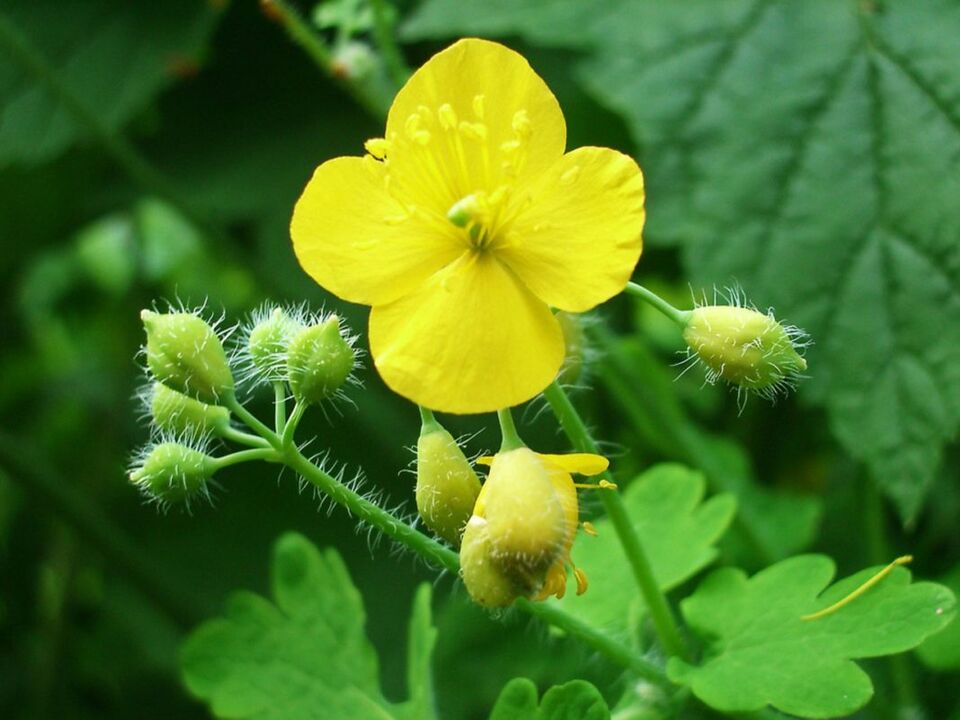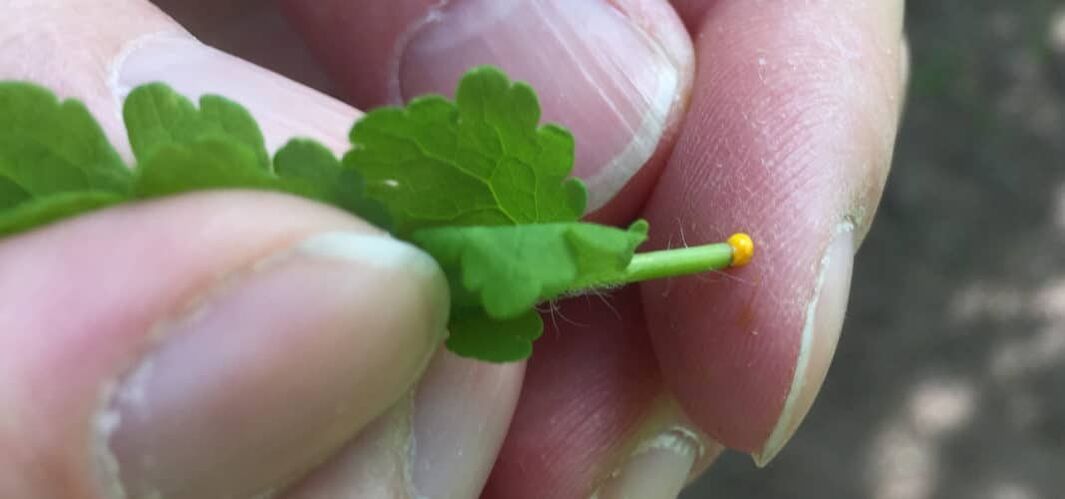The celandine is used in folk medicine mainly because of its yellow milky color. In Europe, Asia and North America, factories are located near settlements. With the advent of synthetic drugs, celandine is increasingly forgotten, which is why it is often called a weed. In the past, medicinal plants were prescribed to combat warts and skin diseases. Clinical efficacy has been demonstrated in two controlled studies. Celandine from papillomas is used in the form of an ointment or gel on problem areas of the skin.
Components and useful properties of celandine against papillomavirus
Clover contains about 20 isoquinoline alkaloids, present mainly in milk juice. The content of alkaloids in the grass is from 0. 48 to 1. 04%, in the roots - up to 1. 95%.
Other chemical compounds in celandine from papillomas:
- organic acids (chelidonic, malic, citric, ferulic acids);
- derivatives of phenolic acids;
- saponins, a large amount of calcium salts and proteolytic enzymes;
- flavonoids;
- biogenic amines (including histamine, tyramine);
- trace amounts of essential oils;
- carotenes;
- vitamin C.
Glycogen is a storage substance in celandine. Seeds contain 40-60% vegetable oil. The plant has a foul odor and a bitter taste. Strong odors can cause sneezing, coughing, and even vomiting in sensitive individuals.
Originally, celandine was found in the temperate and warm regions of Europe and Asia, as well as in the Mediterranean, including North Africa. It was brought to North America by settlers, who used it as a remedy for skin ailments. Cannabis is a typical weed, i. e. it grows on rubble, debris, square yards, cliffs, and on hedges, walls, hedges, fields and grasslands.
Celandine is derived from thick rhizomes, which are orange (like milky juice) inside. The flowers consist of two sepals, four golden yellows, ovate petals and numerous stamens. The capsule is 3-4 cm long, develops from the ovary, the seeds are black, with an oily appendage that ants eat. They also distribute them regionally.
Cedarwood is used to treat spasms in the biliary tract and digestive tract. Traditional medicine as to whether celandine can treat warts is ultimately unproven. The stems, leaves and flowers of celandine contain up to 1% of alkaloids - chelidonine, coptisine and sanguinarine.
According to studies, medicinal plants have anticonvulsant effects, mainly cholera. Therefore, its use in spasmodic disorders of the biliary tract and gastrointestinal tract is medically justified.
Celery also has mild analgesic, cell division inhibitor, and antiviral effects. Two final effects may explain the long-term use of celandine against warts (caused by a virus).
In medicine, celandine is used, collected when it is in bloom (only the aboveground parts of the plant). It is recommended to use only products prepared with standardized alkaloids. The reason is that the plant parts themselves contain an unknown amount of alkaloids. Excess plant matter damages the liver.
Almost all parts of celandine contain alkaloids. Stems contain between 0. 1 and 1% alkaloids, depending on their origin and drying conditions. More than 30 different benzylisoquinoline derivatives (such as benzophenatridine, protoberberine, and protopine) have been identified in laboratory studies. Coptisine is the main alkaloid, accounting for 90%. Chelidonine is the main alkaloid in the roots. Other alkaloids in herbs and roots are berberine, cheearchthrine, sparteine, helidoxanthin, and sanguinarine. In the fall, the chemicals concentrate in the roots, then become highly toxic.
Various plant acids - chelidonic acid, citric acid, malic acid and caffeic acid - are found in small amounts. Clover is not rich in flavonoids. The orange-yellow color of milk is due to carotenoids and some alkaloids such as berberine.

Celery has an antispasmodic effect on the upper gastrointestinal tract and stimulates the flow of bile. The antispasmodic effect is now considered proven. It was possible to demonstrate a biliary effect only a few years ago. In addition, antibacterial, antiviral and anti-tumor effects have been demonstrated for the extracts.
Methods of application in the treatment of diseases
Cedarwood refers to folk remedies, so you should weigh the benefits and risks before using it. A statement has been released advising against taking celandine preparations due to adverse effects on the liver.
Traditionally, raw milk juice was used to treat warts, corneas, and calluses. Protein (proteolysis) and antiviral mechanisms are discussed as primary therapeutic actions. Currently, alkaloid extracts are widely used as standard drugs.
The main use of celandine is to treat skin diseases such as warts or calluses. For upper gastrointestinal cramps, this herb was formerly used as a tea or tincture.
Internal use of celandine is no longer recommended. Because the whole plant contains a high percentage of toxic alkaloids, especially in the roots, it causes poisoning. On the contrary, the detoxifying effect of the ingredients in the dried herbs is reduced. It must be said that the content of toxic components varies by place, crop and season. Each person is different and therefore has different sensitivities to toxins. If the plant is used externally, in some cases it can irritate the skin or cause allergies.
Pharmaceutical preparations based on celandine from papillomas
Products containing celandine are available in the form of capsules, dragees, tablets, and drops. Fenugreek should be used according to the directions on the appropriate packaging or as recommended by your doctor. Traditionally, milky juice of medicinal plants or tincture of celandine is applied to warts to get rid of them. How exactly to use the drug from papillomas, the doctor will tell you.
Since the late 20th century, there have been reports of acute liver injury in patients treated with celandine preparations. Laboratory tests have confirmed the high sensitivity of human hepatocytes to alkaloids present in celandine. As a result, celandine preparations are now withdrawn from pharmacies. According to the European Medicines Agency 2010, the benefits of drug use do not balance the risks to the patient's health.
Folk recipes based on celandine for the treatment of HPV
Not everyone knows how to use celandine properly. Due to its toxic properties, treatment with the plant can only be carried out under the supervision of a doctor. The maximum daily dose is 12-30 mg of alkaloids, that is, 2-5 g of hay. When treating warts, it is recommended to treat warts with milky juice several times a day, trying not to cause blisters on the healthy skin. Care should be taken not to get this juice in the eyes, as it causes a burning sensation. Milk juice packs are useful in treating skin wounds and non-healing wounds.
Decoctions, infusions and capsules
With menstrual problems, human papillomavirus, and stomach cramps, celandine tea or capsules can help. In this case, an antispasmodic property is manifested. However, internal use is not recommended as the ingredients can be toxic. With too high a dose and long-term use will increase the risk of digestive disorders.
Diluted tea and diluted tincture can be used externally for skin diseases - eczema, warts or acne. You should pour 200 ml of boiling water on a teaspoon and let it brew for 10 minutes. Then, wet a cloth with tea and apply to the affected area in the form of a gauze.
Oil and milk solution
To treat warts and warts, celandine milk is used because it contains anti-inflammatory alkaloids. It is recommended to cut a few branches of celandine and apply the yellow juice directly to the affected area 2-3 times daily for several weeks. The juice should be applied only to diseased tissues due to its irritating effect.

You can also make tincture from flowering herbs or roots and use it as a milky juice. Celery tincture is available at health food stores. Since alcohol is not as strong as juice, the shelf life is increased.
Side effects and contraindications
Gastrointestinal complaints have rarely occurred. Some patients have experienced impaired liver function and jaundice with prolonged use of celandine. This may be due to an alkaloid overdose or misuse (eg, severe hepatitis or bile duct). An overdose of celandine can also cause abdominal pain, intestinal pain, and blood in the urine.
Isoquinoline alkaloids are responsible for the toxic effects. Symptoms of poisoning include pain and burning in the mouth, salivation, diarrhea, and coughing up blood. In some severe cases, dizziness, impaired consciousness (including deep coma), hypotension and tachycardia may occur. Cases of fatal poisoning (in children) have been reported. Celery juice can also cause skin irritation (burns, swelling, ulcers) and conjunctivitis (burns, watery eyes). Animal poisoning usually does not happen because they avoid celandine because of the unpleasant smell and taste.
It is necessary to follow the dosage and duration of use indicated in the leaflet or consult a doctor. Without interruption, celandine should be used for up to four weeks.
Celandine should not be used for current or past liver disease, gallstones, cholangitis, biliary obstruction, or liver damage. In addition, pregnant women, lactating women and children under 12 years of age should limit the use of celandine.
If signs of liver damage occur during treatment (eg, yellowing of the skin or eyes, dark urine, upper abdominal pain, nausea, loss of appetite), treatment should be discontinued immediately and a doctor consulted. consultant.
Preparations with celandine can not be used for peptic ulcer, glaucoma and acute catarrh of the gastrointestinal tract. With prolonged use of alkaloids of celandine, there is a risk of developing glaucoma.

























